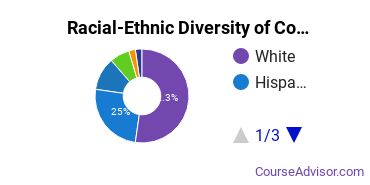Computer & Information Sciences at University of Florida-Online
Every computer & information sciences school has its own distinct culture and strengths. We've pulled together some statistics and other details to help you see how the computer & information sciences program at University of Florida-Online stacks up to those at other schools.UF Online is located in Gainesville, Florida and has a total student population of 4,407.
Want to know more about the career opportunities in this field? Check out the Careers in Computer & Information Sciences section at the bottom of this page.
UF Online Computer & Information Sciences Degrees Available
- Bachelor’s Degree in Computer & Information Sciences
Online Classes Are Available at UF Online
Online courses are a good option for students who need a more flexible schedule that allows them to pursue an education when and where they want. Whether you're going to school part-time or full-time, you may find distance education the right choice for you.
For those who are interested in distance learning, UF Online does offer online courses in computer & information sciences for the following degree levels:
- Bachelor’s Degree
UF Online Computer & Information Sciences Rankings
The computer & information sciences major at UF Online is not ranked on College Factual’s Best Colleges and Universities for Computer & Information Sciences. This could be for a number of reasons, such as not having enough data on the major or school to make an accurate assessment of its quality.
Computer & Information Sciences Student Demographics at UF Online
Take a look at the following statistics related to the make-up of the computer & information sciences majors at University of Florida-Online.
UF Online Computer & Information Sciences Bachelor’s Program

About 51% of those who receive a bachelor's degree in computer & information sciences at UF Online are white. This is above average for this degree on the nationwide level. Prospective students may be interested in knowing that this school graduates 2% more racial-ethnic minorities in its computer & information sciences bachelor's program than the national average.*
The following table and chart show the race/ethnicity for students who recently graduated from University of Florida-Online with a bachelor's in computer & information sciences.

| Race/Ethnicity | Number of Students |
|---|---|
| Asian | 10 |
| Black or African American | 3 |
| Hispanic or Latino | 10 |
| White | 35 |
| International Students | 2 |
| Other Races/Ethnicities | 9 |
Concentrations Within Computer & Information Sciences
If you plan to be a computer & information sciences major, you may want to focus your studies on one of the following concentrations. The completion numbers here include all graduates who receive any type of degree in this field from University of Florida-Online. Some of these focus areas may not be available for your degree level.
| Concentration | Annual Degrees Awarded |
|---|---|
| Computer Information Systems | 44 |
Related Majors
Careers That Computer & Information Sciences Grads May Go Into
A degree in computer & information sciences can lead to the following careers. Since job numbers and average salaries can vary by geographic location, we have only included the numbers for FL, the home state for University of Florida-Online.
| Occupation | Jobs in FL | Average Salary in FL |
|---|---|---|
| Computer User Support Specialists | 41,560 | $49,260 |
| Software Applications Developers | 38,160 | $95,610 |
| Computer Systems Analysts | 24,970 | $85,050 |
| Managers | 23,160 | $99,240 |
| Network and Computer Systems Administrators | 18,780 | $79,070 |
References
*The racial-ethnic minorities count is calculated by taking the total number of students and subtracting white students, international students, and students whose race/ethnicity was unknown. This number is then divided by the total number of students at the school to obtain the racial-ethnic minorities percentage.
More about our data sources and methodologies.
